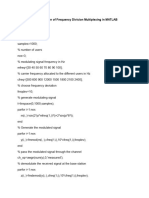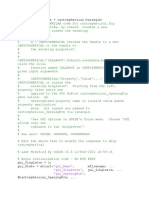0 ratings0% found this document useful (0 votes)
25 views%simulation Length %channel Length %number of Independent Trials
This document presents code for simulating channel equalization using an NLMS algorithm over multiple trials. The code generates training data, applies it to a channel, and adds noise. It then performs equalization using NLMS and averages the results over trials, plotting the final cascade impulse response.
Uploaded by
Oral RobertzCopyright
© © All Rights Reserved
Available Formats
Download as DOCX, PDF, TXT or read online on Scribd
0 ratings0% found this document useful (0 votes)
25 views%simulation Length %channel Length %number of Independent Trials
This document presents code for simulating channel equalization using an NLMS algorithm over multiple trials. The code generates training data, applies it to a channel, and adds noise. It then performs equalization using NLMS and averages the results over trials, plotting the final cascade impulse response.
Uploaded by
Oral RobertzCopyright
© © All Rights Reserved
Available Formats
Download as DOCX, PDF, TXT or read online on Scribd
You are on page 1/ 2
clear all
close all
%simulation length
N = 1000;
%channel length
M = 5;
%number of independent trials
T = 100;
cascade_impulse_response = zeros(1,2*M-1);
for j = 1 : T
%training signal
u = randn(1,N);
%channel to be equalized
c = randn(M,1);
c = c / norm(c);
%channel output
z = filter(c,1,u);
%additive noise to the channel output
SNR = 30;
var_v = var(z) * 10^(-SNR/10);
v = var_v^0.5 * randn(1,N);
%input to the equalizer
x = z + v;
%NLMS channel equalization
w = zeros(M,1);
x_regressor = zeros(1,M);
step = 0.1;
epsilon = 10^(-6);
for k = 4 : N
x_regressor = [x(k) x_regressor(1:M-1)];
e = u(k-3) - x_regressor * w;
w = w + step * x_regressor' * e / (x_regressor *
x_regressor' + epsilon);
end
cascade_impulse_response = cascade_impulse_response +
conv(w,c)';
disp(j);
end
figure;
stem(cascade_impulse_response/T);
title('cascade channel-equalizer impulse response');
xlabel('taps');
You might also like
- Design of Adaptive Equalizer: Using LMS AlgorithmNo ratings yetDesign of Adaptive Equalizer: Using LMS Algorithm8 pages
- Compte Rendu: Electronique Numerique: Réalise ParNo ratings yetCompte Rendu: Electronique Numerique: Réalise Par4 pages
- All All: %two Channel Quadrature Mirror Filter Bank %perfect Reconstruction of InputNo ratings yetAll All: %two Channel Quadrature Mirror Filter Bank %perfect Reconstruction of Input17 pages
- Matlab Code: LMS Adaptive Noise CancellationNo ratings yetMatlab Code: LMS Adaptive Noise Cancellation3 pages
- 9/11/24 9:29 PM C:/Users/vigne/Documents/MATLAB/c.m 1 of 1No ratings yet9/11/24 9:29 PM C:/Users/vigne/Documents/MATLAB/c.m 1 of 11 page
- 1/22/13 11:58 AM C:/Users/Solo... /uwb - SV - Eval - CT - 15 - 4a.m 1 of 4No ratings yet1/22/13 11:58 AM C:/Users/Solo... /uwb - SV - Eval - CT - 15 - 4a.m 1 of 44 pages
- % % Program Name - Prob8261a.m (Modified Problem 8.26 (1), p553) % Comparison of Characteristic Features of Discrete-Time Butterworth, % Chebyshev 1, Chebyshev 2 and Elliptic Lowpass FiltersNo ratings yet% % Program Name - Prob8261a.m (Modified Problem 8.26 (1), p553) % Comparison of Characteristic Features of Discrete-Time Butterworth, % Chebyshev 1, Chebyshev 2 and Elliptic Lowpass Filters10 pages
- To Design and Implement An FIR Filter For Given Specifications100% (1)To Design and Implement An FIR Filter For Given Specifications8 pages
- 'Enter The Length of Filter ' 'Enter The Cut Off Frequency of Filter 'No ratings yet'Enter The Length of Filter ' 'Enter The Cut Off Frequency of Filter '5 pages
- All All 'Enter The Number of Waves' 'Enter The Width of Each Half Period/peak Value' 'Menu' 'Square Wave' 'Triangular Wave' 'Trapezoidal Wave'No ratings yetAll All 'Enter The Number of Waves' 'Enter The Width of Each Half Period/peak Value' 'Menu' 'Square Wave' 'Triangular Wave' 'Trapezoidal Wave'2 pages
- %初始化 %¸个体经验保留 %全局经验保留 %×最大迭代次数 %%微粒数 %问题的规模(城市规模) %迭代计数器 %¸各代最佳路线 % 各代最佳路线的长度 %¸各代路线的平均长度 %产生微粒数的初始位置 for i=1:mNo ratings yet%初始化 %¸个体经验保留 %全局经验保留 %×最大迭代次数 %%微粒数 %问题的规模(城市规模) %迭代计数器 %¸各代最佳路线 % 各代最佳路线的长度 %¸各代路线的平均长度 %产生微粒数的初始位置 for i=1:m3 pages
- CT 303 Digital Communications Lab 9: Heer Gohil 201901135No ratings yetCT 303 Digital Communications Lab 9: Heer Gohil 20190113525 pages
- %newmarks Average Acceleration %eqn For Newmarks Avg AccelerationNo ratings yet%newmarks Average Acceleration %eqn For Newmarks Avg Acceleration1 page
- Codes For North West Corner Cell Method, Least Corner Cell Method and Vogel'S Approximation MethodNo ratings yetCodes For North West Corner Cell Method, Least Corner Cell Method and Vogel'S Approximation Method8 pages
- Experiment No:1: Aim:Write A Program For Sampling. Software Used:matlab TheoryNo ratings yetExperiment No:1: Aim:Write A Program For Sampling. Software Used:matlab Theory44 pages
- %tiempo de Bit (Segundos) %frecuencia de Muestreo (HZ) %periodo de Muestreo (HZ)No ratings yet%tiempo de Bit (Segundos) %frecuencia de Muestreo (HZ) %periodo de Muestreo (HZ)5 pages
- Digital Signal and Image Processing using MATLAB, Volume 3: Advances and Applications, The Stochastic CaseFrom EverandDigital Signal and Image Processing using MATLAB, Volume 3: Advances and Applications, The Stochastic Case3/5 (1)
- Fundamentals of Electronics 3: Discrete-time Signals and Systems, and Quantized Level SystemsFrom EverandFundamentals of Electronics 3: Discrete-time Signals and Systems, and Quantized Level SystemsNo ratings yet
- Simulation and Analysis of Cognitive Radio System Using MatlabNo ratings yetSimulation and Analysis of Cognitive Radio System Using Matlab16 pages
- List of Candidates Participating in Antenna Theme Photography ContestNo ratings yetList of Candidates Participating in Antenna Theme Photography Contest3 pages
- Bandwidth Is Another Fundamental Antenna Parameter. Bandwidth Describes The RangeNo ratings yetBandwidth Is Another Fundamental Antenna Parameter. Bandwidth Describes The Range6 pages













































































